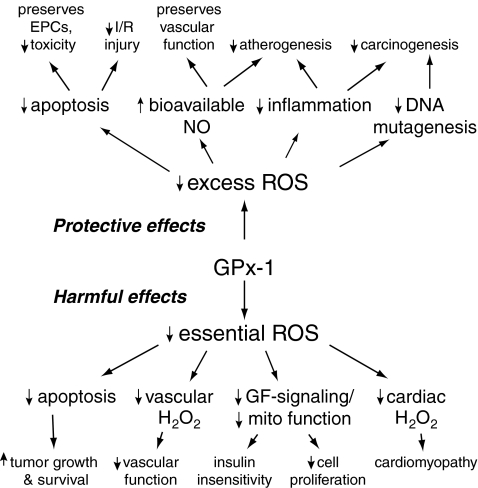FIG. 13.
Protective and harmful effects of GPx. This diagram illustrates some of the protective effects (top half) and harmful actions (bottom half) of GPx-1 that are mediated by decreasing cellular ROS. Thus, elimination of excess ROS can protect against apoptotic cell loss or injury during ischemia-reperfusion (including coronary and neuronal); protect against cell toxicity to drugs (preserving neurons, cardiomyocytes, and other cells); and protect cells and susceptible cells against high ROS, including endothelial progenitor cells (EPCs), and β-cells in pancreatic islets. In addition, removal of excess ROS can preserve bioavailable NO, preserving vascular function, which also decreases thrombosis and is antiatherogenic. GPx-1 has also been shown to protect against inflammatory stimuli that may promote a proatherogenic state and foster carcinogenesis. In addition, GPx-1 prevents DNA mutagenesis, which also decreases carcinogenic potential. Harmful effects of GPx-1. Note that many of the harmful effects of GPx-1 occur under conditions of excess GPx-1, which may be induced by physiological conditions such as mechanical stress in the vasculature (375) or under pathological conditions such as in certain cardiomyopathies (297, 405). Overall, by reducing excess oxidants, GPx-1 may allow for tumor survival and growth. Further, removal of essential oxidants can create a reductive stress characterized by loss of normal physiological responses, including reduced vascular responses to hydrogen peroxide and arachidonic acid; decreased mitochondrial function and growth factor (GF) signaling that can cause insulin insensitivity and decreased cell proliferation; and development of cardiomyopathies by mechanisms not completely understood but presumed to involve a reduction in essential levels of hydrogen peroxide.

